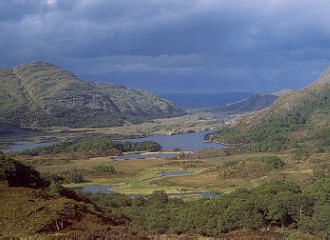 |
 |

Killarney
[Friday - 11/15/02] As with the rest of the County Kerry region, Killarney's unique history began with the last Ice Age. A single ice sheet covered the entire region. As it melted, it sculpted Killarney's magnificent peaks Carrantoohill, Crohane, Tomies, Torc, and Mangerton. Pushing aside huge boulders and gravel, it created the winding passes of Moll's Gap and the Gap of Dunloe. The retreating ice also formed dark, mysterious loughs. The Long Range (Upper Lake, Muckross Lake, and Lough Leane), Lough Guitane, and the Devil's Punch Bowl are all glacial remnants.
The area's first human residents were Bronze Age Beaker Folk, from around 2000 BC. They mined copper on Ross Island and also left the open-air temple at Lissyvigeen. Beginning in 500 BC, successive waves of invaders culturally changed the area. Pictish tribes from the north of Ireland were the first invaders. According to legend, the ruling tribe in Killarney was descended from Queen Mebh's son Cair and was known as the Ciarraige. It is from this name that "Kerry" is derived.
In approximately 400 BC, the next wave came with the Fir Bolg or Iverni. The name Fir Bolg means, "bag men." One explanation often given for this name is that they exported Irish earth to the Greeks to protect their cities from snakes. Expert stonemasons, the Fir Bolg created the stone forts Staigue, Cahergall, and Leacanabuaile centuries later. They also developed Ogham script, fine examples of which can be found near Killarney. A Celtic people, they gave Ireland some of its richest legends. The tales of Cuchulainn, Deirdre, and Curoi are all attributed to them; it is thought that the great Irish saga 'Tain' tells of the Fir Bolg's battles with the next invasion group, the Gaels.
The Gaels - who later called themselves the Milesians - arrived in 100 BC. Although a fierce, warring race, it still took them 500 years to dominate the other two groups and eventually settle their power base around Killarney.
Until 400 AD, Killarney remained under Gael rule with the Ciarraige and Fir Bolg paying tributes. The first Christian communities were established around this time with St. Abban building a cell at Aghadoe. Christianity was accepted quite readily in Kerry, with pagan festivals and rites readily assimilated. By 633 AD, Gael, Faithliu, established the monestary on Innishfallen Island. Although the Geraldines came as far as Aghadoe and built a castle on the site of Parkavonear, the Gaels ruled undisturbed for 200 years until they were overthrown by the O'Donoghue/MacCarthy's. From 1200 onwards, the Anglo-Normans, based at Ballymalis Castle, launched successive attacks on the O'Donoghue/MacCarthy chieftains and were defeated in 1261. During the relatively peaceful centuries that followed, the O'Donoghue/MacCarthy family built Ross Castle and Muckross Abbey. Then in 1583, the English defeated the O'Donoghue/MacCarthy's, and most of their lands were awarded to Sir Vincent Browne.
The Brownes became Earls of Kenmare and had the single biggest influence on Killarney. In the 15th century, English Protestant settlers were given land and a Cromwellian military post was set-up at Ross Castle. These soldiers then sought out and hung Irish Catholic "revolutionaries." The poet Piaras Ferriter was one victim and the Speir Bhean Monument commemorates him. The priest Thaddeus Moriarty was another, arrested for saying mass at Killaclohane Mass Rock. Remarkably, the Brownes remained Catholic throughout this period and never lost power.
Killarney continued as a small market town until 1750. Viscount Kenmare, seeing a great promotional opportunity, decided to capitalize on nature's bounty. He invested in roads, boat facilities, and gave out long leases for new inns beginning the town's tourist industry. During this same period, the lands around Muckross transferred to the Herbert family. The Herbert's amassed a considerable fortune by mining copper along the Muckross peninsula. In 1793, Rudolf Erich Raspe, the author of The Surprising Adventures of Baron Munchausen, was employed as estate geological adviser. He died from a fever in November 1794 and is buried in nearby Killegy Churchyard.
With the continued encouragement of the Brownes, St. Mary's Cathedral, St. Mary's Church of Ireland, the Presentation Convent, and a new Franciscan Friary were all built in the early 19th century. Both the Herberts and Brownes also built grand, new estate houses at Muckross and Knockreer. This prosperity was halted in the autumn of 1845 when the potato blight struck. Partially built, St. Mary's Cathedral was used as a fever hospital. The population of the large workhouse, built in 1845 to house 800, had swelled to 1200 by 1847. The Herberts and Brownes were active in Famine relief, cutting personal expenditures to supply soup and agricultural expertise for their tenants.
By 1850, the ravages of the Famine had faded and Killarney's role as a tourist center returned. In 1861, with an entourage of over 100, Queen Victoria arrived. A panorama on the Muckross estate, enjoyed by her ladies-in-waiting, was dubbed Ladies View, a name it has retained.
The Muckross estate was sold in 1899 to Lord Ardilaun, a member of the Guinness family. Then in 1910 it was sold to a wealthy Californian, William Bowers Bourn, who gave it to his daughter as a wedding gift. Maud Bowers Bourn married Irishman Arthur Rose Vincent and made the estate their home. After Maud's tragic death in 1929, Arthur Rose Vincent decided to give the estate to the Irish nation. This was finalized in 1932, making Muckross the first Irish National Park. The National Park has continued to grow over the years and it now includes approximately 26,000 acres.
|
Last modified on Wednesday, November 26, 2008 URL: http://www.housecorvus.org/kil.htm Copyright © 2002-09 House Corvus. All rights reserved. Design and hosting by Bran Trefonnen. | |